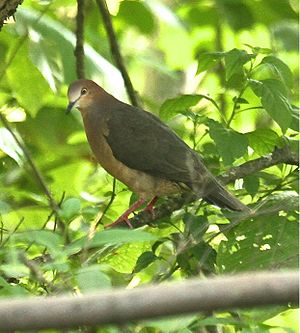Yellow-bellied pigeon
| Yellow-bellied pigeon | ||||||||||
|---|---|---|---|---|---|---|---|---|---|---|

Yellow-bellied pigeon ( Leptotila ochraceiventris ) |
||||||||||
| Systematics | ||||||||||
|
||||||||||
| Scientific name | ||||||||||
| Leptotila ochraceiventris | ||||||||||
| Chapman , 1914 |
The yellow-bellied pigeon ( Leptotila ochraceiventris ) is a species of pigeon birds. It occurs exclusively in South America. The yellow-bellied pigeon is considered to be endangered ( vulnerable ).
Appearance
The yellow-bellied pigeon reaches a body length between 23 and 25 centimeters. It is a little bigger than a laughing dove .
The males of the yellow-bellied pigeon have a pale, wine-reddish forehead that merges into a wine-reddish crown. The nape and the back of the neck are brownish wine-red. On the coat there is a band of feathers shimmering in metallic purple and reddish. The elytra, the back, the rump and the upper tail-coverts are dark olive-brown. The outer pairs of rudder springs are black with broad white tips.
The chin is white, the throat is isabel to creamy white, the face is cinnamon to dark isabel and the sides of the neck are reddish-cinnamon. The breast is dull pink and turns into a cinnamon-colored to sock-colored belly. The flanks and the under tail covers are also cinnamon colored. The under tail-coverts are black-brown with large white tips. The iris is straw yellow, the featherless skin around the eye is reddish purple. The beak is black. The legs and feet are coral red.
The females are generally a little more dull in color than the males. The metallic shimmering part of the plumage on the coat is also smaller. The young birds are significantly darker than the adult birds. The feathers of the wing covers and the breast still have cinnamon-colored hems. Their feet and legs are still dull red.
Possible confusion
In the distribution area of the yellow-bellied pigeon, there are several other types of sound-swinging pigeons that they can be confused with. The white-forehead dove is slightly larger than the yellow-bellied pigeon and is paler overall. It also has a wide white central band on the control feathers and the featherless skin around the eye is blue and not red as in the yellow-bellied pigeon. In addition, the call, which is two-syllable in the white-forehead dove, differs.
The pale pigeon is also larger and paler than the yellow-bellied pigeon . It is bright maroon on the top of the body and very light on the underside of the body.
Distribution area and habitat
The yellow-bellied pigeon has a comparatively small distribution area and is only found in the southwest of Ecuador and in the northwest of Peru. It settles here at altitudes between 500 and 1800 meters above sea level. It has also been spotted at altitudes of 2625 meters. There is evidence that the yellow-bellied pigeon makes seasonal high-altitude migrations. During the dry season it migrates to higher altitudes.
Historically, the yellow-bellied pigeon also occurred in forests on the lowlands. However, due to deforestation in these regions, it has completely disappeared from these areas. The increasing deforestation and the fragmentation of the remaining forest stands are one reason for the endangerment of the species.
The habitat of the yellow-bellied pigeon are primary forests and tall secondary forests with a dense undergrowth. It is therefore dependent on the fact that there is no forest pasture for cows and goats in its area of distribution. It occurs in both hardwood and evergreen tropical forests, but appears to use these forest types depending on the season and rainfall. This makes it a living space specialist. It occurs in the mountain rainforests of the Tumbes region from January to March and during this time it avoids the adjoining drier hardwood forests. You can find her there from July to September. Their reproduction time also varies greatly from region to region and appears to be dependent on the availability of food, which in turn seems to be influenced by the type of forest and the respective climatic conditions.
Way of life
The nest of the yellow-bellied pigeon is a pigeon-typical loose platform consisting of small branches that is erected between one and three meters above the ground. The platform is laid out with small roots. The clutch consists of two eggs.
literature
- David Gibbs, Eustace Barnes and John Cox: Pigeons and Doves - A Guide to the Pigeons and Doves of the World . Pica Press, Sussex 2001, ISBN 90-74345-26-3 .
- Alois Münst and Josef Wolters: Tauben - The species of wild pigeons , 2nd expanded and revised edition, Verlag Karin Wolters, Bottrop 1999, ISBN 3-9801504-9-6 .
- Gerhard Rösler : The wild pigeons of the earth - free living, keeping and breeding . M. & H. Schaper Verlag, Alfeld - Hannover 1996, ISBN 3-7944-0184-0 .
Web links
- Leptotila ochraceiventris inthe IUCN Red List of Threatened Species 2016.1. Posted by: BirdLife International, 2016. Retrieved December 19, 2016.
Single receipts
- ↑ Leptotila ochraceiventris in the IUCN Red List of Threatened Species 2016.1. Posted by: BirdLife International, 2016. Retrieved December 19, 2016.
- ↑ a b c Gibbs, Barnes and Cox: Pigeons and Doves , p. 368.
- ↑ a b Gibbs, Barnes and Cox: Pigeons and Doves , p. 369.